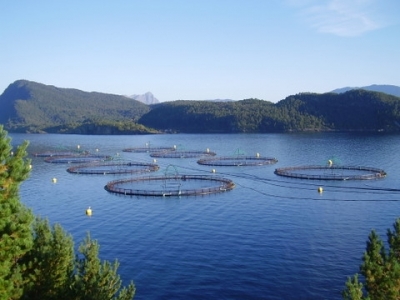Interpretation of Water Analysis Reports for Fish Culture
Some aquaculture producers and pond owners choose to submit water samples to a water quality labora-tory for analysis.
 Fertilization of Fish Ponds
Fertilization of Fish Ponds When ponds are fertilized, nutri-ents stimulate the growth of microscopic plants in the water (phytoplankton). Phytoplankton is food for other organisms
 Characterization and Management of Effluents from Aquaculture Ponds in the Southeastern US
Characterization and Management of Effluents from Aquaculture Ponds in the Southeastern US Nearly all commercial aquaculture in the southeastern United States is conducted in earthen ponds. Good production from ponds is encouraged by using
 Light Penetration in Water
Light Penetration in Water The depth of the photic zone, the layer of water receiving 1% or more of incident light, can be estimated with Secchi disk visibility.
 Water Temperature in Aquaculture
Water Temperature in Aquaculture Aquaculture ponds should not be deeper than about 2.0 m to minimize the probability of thermal stratification.
 Mechanical Water Circulation Aids Pond Water Quality
Mechanical Water Circulation Aids Pond Water Quality Mechanical water circulation can prevent stratifica-tion and provide more dissolved oxygen near pond bottoms
 Overview: Mechanical Pond Aeration
Overview: Mechanical Pond Aeration Productivity increases in aquaculture ponds in re-sponse to nutrient inputs of fertilizer and feed. These in-puts, however, increase the demand for oxygen
 Specific Conductance – Alternative Salinity Measurement
Specific Conductance – Alternative Salinity Measurement The refractive index of water changes in a pre- dictable way with increasing salinity. Salinity refractometers are calibrated so they provide direct readings of
 Salinity Balance Key To Culture Success
Salinity Balance Key To Culture Success Like some other penaeid shrimp, P. monodon can tolerate a wide salinity range
 Carbon Dioxide: Waste, Nutrient
Carbon Dioxide: Waste, Nutrient In low-alkalinity waters, application of liming materials helps increase pH
 Total Alkalinity, Total Hardness
Total Alkalinity, Total Hardness Proper management of phytoplankton in aquaculture ponds is important to maintain adequate water pH levels.
 Water Composition: Dissolved Inorganic Solids
Water Composition: Dissolved Inorganic Solids Interest in inland aquaculture is growing, but inland waters can have ionic imbalances that affect the growth and survival of cultured species.
 Anion-Cation Balance: Cross-Check for Reliability of Ion Analyses
Anion-Cation Balance: Cross-Check for Reliability of Ion Analyses Testing ion balance can help ensure suitable aquaculture conditions for shrimp and other species.
 Phytoplankton a crucial component of aquaculture pond ecosystems
Phytoplankton a crucial component of aquaculture pond ecosystems Ponds typically contain an abundance of phytoplankton. These organisms play an important role in pond ecology and influence water quality
 Decomposition and accumulation of organic matter in ponds
Decomposition and accumulation of organic matter in ponds The major sources of organic matter in aquaculture ponds are organic fertilizer, remains of microorganisms — phytoplankton, zooplankton, and benthos — produced
 Phytoplankton in aquaculture ponds: Friend or foe?
Phytoplankton in aquaculture ponds: Friend or foe? Phytoplankton can be a dilemma in aquaculture. Properly managed populations can be very beneficial (“friend”) to aquaculture production systems
 How will climate change impact seafood production?
How will climate change impact seafood production? Climate change poses a major threat to global food production – including seafood and aquaculture, and the challenge is how to continue feeding a growing global
 Waste Removal Methodologies
Waste Removal Methodologies Wastes must first be removed from the culture water and then disposed of in an environmentally benign manner, or preferably, in a profitable manner.
 Water quality and Water quality Management in Aquaculture
Water quality and Water quality Management in Aquaculture Aquaculture can be defined as the high-density production of fish, shellfish and plant forms in a controlled environment.
 Recirculation Systems in Aquaculture
Recirculation Systems in Aquaculture Recirculation systems are becoming increasingly popular as they provide a predictable and constant environment for growing fish.
